
Official Edgar Rice Burroughs Tribute and Weekly Webzine Site
Since 1996 ~ Over 15,000 Web Pages in Archive
Presents
Volume 1328

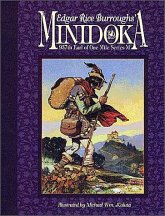 |
ERB's Practice Run At His Career: Minidoka 937th Earl of One Mile Series M by R. E. Prindle |
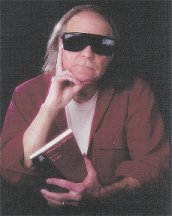 |
All around the water tank,
Waiting for a train.
A thousand miles away from home,
Sleeping in the rain.~ Jimmie Rodgers -- Waiting For A TrainThe question is why did Edgar Rice Burroughs delay his writing career until he was thirty-five and what prompted him to begin? I think the answer lies in Our Man's conception of himself. To consider only two key events which formed that conception:
1
The basis of ERB's character was formed on a street corner in Chicago in 1885 when he was in the fourth grade. The ascertainable facts are that his father, George T., employed two Irish maids and that ERB was confronted on a street corner by a twelve-year-old bully named John who terrorized our young man destroying his youthful identity while grafting his own onto it.
I offer a reconstruction of the probable course of events. In those days there was a terrific conflict between the Irish immigrants and the Anglo natives. The Anglos then, as now, considered themselves superior to the Irish or Celts as they were collectively known. In those days the conflict was often characterized as between Celts and Anglos, two different incompatible psychological outlooks.
George T. Burroughs, who was very proud of his English ancestry, probably encouraged young Burroughs to hold the Irish in some contempt. As young people will, ERB probably allowed the two Irish maids to perceive his scorn for the Celt. Ask why did John the Bully single out ERB for terrorization?
It could have been chance but it is more likely that the Irish maidens taking umbrage at Burroughs' attitude asked a young Irish lad, probably a relative, to teach ERB a lesson. This is the way things usually happen.
Remember that at this time the Irish were new to the country. It is possible that John the Bully was born in Ireland being first generation immigrant with all the attendant anti-English prejudices and hatreds. In all events he was the son of first generation immigrants who bore the culture of the Ould Sod, that little emerald green island, not only in their manners but in their genes.
Thus, on that fateful morning a twelve-year-old Irish hoodlum, who later appeared in the character of Billy Byrne, mucker, stopped ERB on the street corner on the way to Brown School changing his life forever.
ERB subsequently symbolized this incident in variations on the theme of his hero sailing placidly on a yacht which represented ERB's early life, a sudden squall arises "in which no ship can live," which represents the confrontation with John the Bully, the ship sinks, in other words ERB loses his identity, the hero is separated form the respectable people to be thrown amongst the bad lot, muckers, or, life after John. The hero then has to find his way back to respectability which leads to the Burroughsian corpus.
This story is the basic plot of ERB's novels. Each book is variation after variation after variation on this theme. I personally do not find the fixation formulaic, although some may argue.
Thus as will be shown ERB identified on the one hand with the outcasts and hoboes while on the other with the respectable folk. This makes for a nice literary contrast making the corpus endlessly interesting.
The second critical event occurred on the return trip from a visit to New York City in August of 1899 (see letters in ERBzine 1177) This incident was even more critical than that with John the Bully. ERB was assaulted in Toronto during which he received a terrific blow to his forehead with what must have been a sandbag, sap, blackjack or lead pipe. ERB was knocked flat on his back opening up a large cut although he was not aware of losing consciousness. His companions nevertheless took him to the hospital. We are unaware of exactly how long he was there. Subsequent to the blow he suffered from haziness or cobwebs for several months. He then suffered from severe headaches for several years accompanied with periods of amnesia accompanied by a serious impairment of memory.
It would seem likely that he suffered brain damage which lasted at least decades although it may have progressively diminished over the years.
ERB's symptoms fit a clinical description of a sort of condition which I came across in Per Brodal's The Central Nervous System: Structure and Function, 3rd Ed., Oxford, p. 433:
A peculiar form of amnesia occurs together with confabulation: that is, the patient invents stories (without knowing that they are not real). Most of the patients have a lesion involving the substantia innominata, the medial hypothalamous, and the orbitofrontal cortex (usually caused by a ruptured aneurysm in the anterior cerebral artery). The often bizarre stories can usually be traced back to real events, although they consist of various unrelated fragments from memory. It seems that the patient is unable to suppress irrelevant associations, and cannot check them against reality.The above seems to me to be a pretty accurate description of ERB's writing style. For all we know he was able to enter an amnesiac state when he wrote not unlike John Carter's departure for the Red Planet in A Princess of Mars.Although there is now no way of determining for certain it seems not unlikely that between the crash of the sap on his forehead, the fall to the ground with a possible bump to the back of the head, his brain was set into a rapid back and forth motion inside his skull which bruised his forebrain causing the months of cobwebs while he probably ruptured his anterior cerebral artery which bled leaving a clot whose pressure resulted in the severe headaches and periods of amnesia.
The clot would probably disintegrate after a couple decades relieving pressure.
Between the psychological hypnoid state imposed on him by John the Bully and the physical brain injury caused by the sandbag in Toronto one is amazed at the phenomenal output of ERB when once he took pen in hand.
Let us now consider possible triggers that set him to writing when he did.
Robert Barrett, who wrote the introduction to the Dark Horse edition of Minidoka, dates the writing of the story to 1903-05 because he believes it discusses events of that period. It is true that ERB places the location of the story in the context of 1900-05, which is indicated by the use of letterheads from the Yale Dredging Company for writing paper, but it might also be related to ERB's stay in 1898-99 since he also used letterheads from his stationery store. But the actual events of the story concern the years 1896-1900 and his wooing and winning of Emma from Frank Martin.
2It is possible to make a reasonable conjecture on why ERB placed the action in Idaho while it occurred elsewhere. ERB retells this portion of the story in his 1913 novel: The Girl From Farris's. Girl was ERB's fifteenth tale written in 1913 placed between "Men and Beasts" and Thuvia, Maid of Mars.
In it the hero, Ogden Secor, is beaten about the head and shoulders as he interrupts two burglars who are rifling his safe, i.e. Martin and Patchin, who are trying to steal ERB's girl. From then on Secor suffers from serious mental afflictions. He has memory troubles, not being able to remember from one moment ot the next what has just happened. He doesn't recognize people while being unable to conduct his business. People wonder what is going on in his head. He would have appeared daffy as I'm sure ERB did during those years.
Finally becoming bankrupt while having turned to drink, wallowing in despair, he remembers that he has a farm in Idaho which was not lost in the bankruptcy because he had forgotten it as an asset. Having nowhere else to go he leaves for Idaho where in the story his redemption occurs just before he returns to Chicago, which would be in 1904.
Head troubles may explain why ERB took Emma to Idaho and why Minidoka is placed in that context. Unfortunately for ERB there is no evidence that he found redemption in Idaho.
Anent to ERB's head injuries, writing here in 1913 on p. 146 of the 2004 Wildside press edition of Girl he says this:
He (Secor) grew to take a keen pleasure in physical fitness, and with renewed health of body came a return of his former mental efficiency -- what the surgeons tinkering with his hurt skull, had been unable to accomplish, nature did; slowly it is true, but none the less effectively.Thus it would appear that ERB had been seeing doctors about his problems over the years, if so, there must be some record of it in the archives, I doubt if his physical fitness program had completely eradicated his problem but it may have been helping.
That ERB himself was into physical fitness is proven by the 1916 photo on the dock at Coldwater where he is flexing his muscles.
Rather than 1903-05 I would assign a date for Minidoka's writing to 1908-09 or specifically the first quarter of '09.
When John the Bully terrorized ERB on the way to Brown School he caused several effects on the lad's character. On the one hand he emasculated the boy and on the other he declassed him.
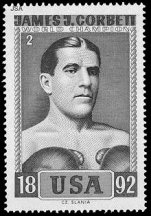
James J. Corbett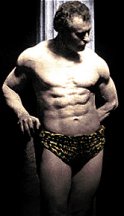
The Great SandowBecause of his emasculation ERB virtually worshipped heavyweight boxers like Jim Corbett and professional strongmen like the Great Sandow. ERB could observe both men up close and personal at the Columbian Expo in 1893. He may even have spoken to both men. Tarzan is probably to some extent based on both Sandow and Corbett although as Burroughs repeatedly points out Tarzan didn't have the bulky build of the strongman but "smooth rippling muscles" more like Corbett. The Big Bwana was nevertheless as strong or stronger than Sandow and as sleek or sleeker than Corbett.
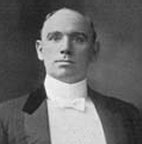 |
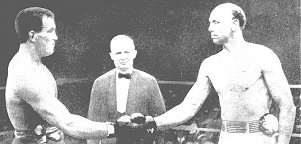 |
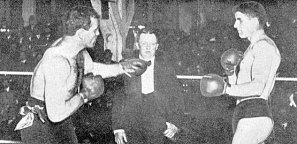 |
During the years of Burroughs' youth until 1905 when Jim Jeffries retired undefeated, with the exception of Bob Fitzsimmons, all the heavyweight boxing champions had been Irish. Thus ERB was constantly reminded that the Irish were his physical superiors as had been the Irish John the Bully.In 1905 after Jeffries retirement an Anglo named Marvin Hart held the title for a few months to be succeeded by the Canadian Tommy Burns who, although Italian, fought under an Irish name passing for Irish to boxing fans. He was challenged by the Negro contender Jack Johnson. Burns didn't want to fight a Black, doing all he could to avoid the fight. He was run to ground Christmastime 1908 in Sydney, Australia by the not-to-be-denied Jack Johnson. Johnson finished Burns off to become the first Black heavyweight champion.
In Burroughs' hypnoid emasculated psychological state he had to be rooting for the non-Irish underdog. As Burroughs himself felt as inferior and put upon as a Negro Johnson's victory was as a victory for himself. The lid on his inhibitions, writer's block, came partially off. I believe that at that time he sat down to write, probably dashing Minidoka off in a couple weeks. He undoubtedly found the story unsatisfactory. The train he was waiting for was braking to a stop at the water tank. He wasn't any closer to home but his ride was in sight.
At this point ERB formed an attachment, a bond of sympathy to Jack Johnson that lasted at least until the boxer was railroaded into prison in 1919.
The success of Johnson was an affront to Whites in general and the Irish, whose representative he defeated, in particular. The idea of the Great White Hope arose at this time. The only Hope the Irish could come up with was to call the undefeated Jim Jeffries, who was therefore still the "real" champ, out of retirement.
This particular edition of the fight of the century was scheduled for Independence Day, July 4, 1910. Originally scheduled for San Francisco, that Irish stronghold declined the honor, the fight was move to Reno, Nevada. There, Jack Johnson had no trouble in putting the mighty Jeffries down for the count.
I believe this event blew away Burroughs' inhibitions allowing him to begin his writing career in earnest. As the train pulled away from the water tank ERB was riding the rods, he wasn't on the cushions yet.
When Burroughs was declassed he began to develop a penchant for the hobo which would assume dominance in his character by the time he wrote "Out There Somewhere" (The Return of the Mucker) in 1916.
The hobo ruled the Haradom of the North, Chicago, in Minidoka.
The Windy City was the rail crossroads of America. The transient hobo population formed a significant part of its population. Every summer armies of hoboes hopped trains in Chicago to fan out for the great harvest of the Midwest farmlands. The harvest finished, the trains brought the migrant workers back to Chicago to lounge around for the Winter.
One can only imagine the wonderment with which the young Burroughs perceived this phenomenon.
He became very familiar with the wandering lads in 1904 when he worked as a railway shack for the Oregon Short Line in Salt Lake City.
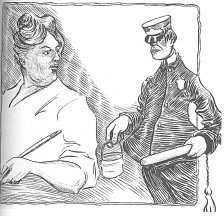
Salt Lake Cartoons by ERB ~ Not for Reproduction ~ Copyright ERB, Inc.In a youth filled with lows ERB hit a new bottom in Salt Lake. Unable to make ends meet he sold up his and Emma's belongings to move back to Chicago, no redemption there. ERB must have worn out his relationship with both his brothers in Idaho and his father in Chicago. Either they would no longer send him railway fare or he was too proud to ask.
Ever improvident, Burroughs used the money realized from his "garage sale" to buy First Class tickets back to Chicago. He and Emma were not only riding the cushions, to use the hobo term, but riding in style. I would imagine the return to Chicago was a trip of reflection. I would imagine that as Burroughs looked out the windows as they were passing through the jungles he wondered just how great a distance separated him from the hoboes. Perhaps he smilingly recognized one or two from the rail yards of the Shortline pointing them out to Emma with an appropriate story. He didn't romanticize the life as "Out There Somewhere" shows but he had the feeling that he belonged with them. Perhaps The Mucker Trilogy had its inception on that ride. That aspect of his personality began to assume the ascendancy.
This attitude was reinforced by the bitterly romantic hobo poetry of Robert Service and H. H. Knibbs, both of whom began to surface at this time. I rather suspect that ERB was an aficionado of hobo songs and poetry.
By 1908 all Burroughs lows were at the same level as he bumped along a long rocky bottom something like a flat stone skittered across a pond. Yea, ERB knew despair.
Having established a probable cause or impetus to set Burroughs on his writing career in 1909 let us now consider the content of Minidoka.
3
ERB chose as a first effort the difficult genre of the humorous or comic novel, perhaps in emulation of Mark Twain. While overly compressed, as might be expected of a first effort, the story succeeds reasonably well. Burroughs relies heavily on reversals in language and detail for comic effect.
The tale may reflect a number of verbal mannerisms Burroughs used to entertain the boys around the water tank. I hope the mannerisms were more successful for him than they have been for many of us latter day types. I not only had to abandon them long ago but I wish the up an coming types would too, soon.
Still Burroughs turned out a light breezy style which is more attractive in print than around the water tank while being something he was never able to duplicate again although there are some similarities in Tarzan and the Forbidden City.

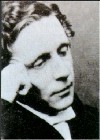
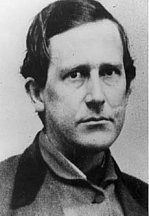
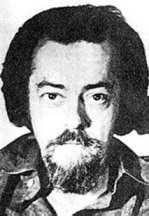
I haven't read Edward Lear but as Barrett points out in his introduction there are abundant traces of Lear and Lewis Carrol with probably a very large dash of Stephen Foster's nonsensical "Oh Susanna." Lin Carter in one of his introductions to the Ballantine Fantasy Series points out that he found evidence of William Morris in the corpus. I doubted it but there seems a clear possibility that there are influences from Morris' Well At The World's End and The Water of the Wondrous Isles in this story. The reference to the "Edge of the World" for instance.There is an interesting episode in Water of the Wondrous Isles in which a witch conjures up phantom bowmen who fail because a protagonist not being hypnotized recognizes the ploy. I was struck by the resemblance to the Lotharians in Thuvia, Maid of Mars.
Over all, Minidoka is the story of the struggle between ERB and Frank Martin for the hand of Emma Hulbert and the aftermath of the fight in Toronto. The former struggle took place in 1896-1900, while the latter covers the years 1900-1905.
As in real life, ERB began the period in the army but as an enlisted man and not as the "Commandant of the Conners Own Royal Light Cow Guards."
Here, at the very beginning ERB interjects a certain antipathy to the Irish which carries through the story. If the Brady is meant to represent Emma's father then ERB even makes him Irish. This may relate to an incident in the twenties when ERB asked Emma's mother for a genealogical chart. Mrs. Hulbert replied testily, as I read it, that he could see that the family was English on both sides -- which was actually more than ERB could say for himself.
If opening paragraphs are meant to set the tone, as I think they are, ERB begins like this:
Many erstwhiles since, a portion of Idaho was ruled over by an extremely ill-natured and wicked Brady called Pzvrtjhk. The Prime Minister and a few of the Brady's favorite nobles, who still had heads for everyday wear, called him "Smith" for short . . . .There you have it. A plague on the Irish and why don't they pack up and go back to where they came from?All the civilized world was divided into kingdoms ruled over, in North America, by the Bradys, or Hara's or Malleys, or Conners . . .
Some other time I will tell you how these mighty people were persecuted by their gods, who sent plagues and fevers and then some more fevers and how the sturdy rulers fought against them until one particularly malicious god conceived the idea of sending a yellow fever, and how the blow almost killed one poor forefather who gathered his clans and sailed away to a little island across the seas which they chose because of its color on their maps; it was a beautiful emerald green.
For the rest of it, Minidoka's relationship with the Brady is a struggle between them for his daughter.
Minidoka achieves his end but as an inside joke which only Emma could have gotten, the Brady imposes conditions. p. 54:
Our only other condition is that you accept, in addition to my daughter's hand, the south wing of our Golden Palace at Wapi as your future home.As we all know Burroughs was denied the house by the "ill-natured and wicked" Brady Hulbert and that he and Emma moved into the Hulbert home after they were married. ERB makes another reference to this in The Lad and the Lion when the Lad and Nakhla move into the Sheik's tent after marriage.
In the interim between wooing and winning there is the struggle for Emma's hand with the Godling, Rhi.
When I was younger a boy who demanded too much was asked: "Who do you think you are? Little Lord Fauntleroy?" this was a little bit of a quiz because I had no idea who Little Lord Fauntleroy was. Similarly the kid down the block who put on airs might derisively be called a Godling.
As the Godling Frank Martin was a millionaire's son, that Emma would choose ERB over him was, one might say, a tribute to ERB's line of talk.
In the trios descent to Nevaeh ERB describes them thusly:
The lovely princess, The Mighty Fighter and the Beautiful Godling.
Why he didn't capitalize lovely princess and made the godling beautiful is open to guess. He is obviously the Mighty Fighter, while Frank Martin is the Beautiful Godling.
On p. 59 when Rhi proposes to Bodine ERB describes it this way:
Rhi: I beg you to fly with me and become Mrs. Godling. (ERB aside) This was the chance of a lifetime and from a real thoroughbred Godling, too . . .So I think we can safely assume that Frank Martin was formidable competition while Emma's father must have blustered mightily for Frank while inveighing nastily against the poor ne'er-do-well, Ed Burroughs. I'm sure you can see the poor old dad's dilemma. God, he could have grouind his teeth to stumps.As ERB tells it, Bodine/Emma's response to the proposal was:
Snatching away her hand, she rose to her full height and pointing to the door, cried: "Never-r-r-h! Back to the woods. There'll be no flight tonight. If Minidoka is defunct I'll go into deepest mourning for black becomes meh style of beauty.As Burroughs says of Bodine he might have said of Emma:
Go . . .-- but Bodine was true blue -- all wool and a yard wide.I should say so. As I write this I become increasingly amazed that Emma would turn down a proposal from a millionaire real thoroughbred Godling to remain with a ne-er-do-well without a real job or any prospects. Can you imagine how blisteringly angry she must have been when ERB threw his hat on the couch crying: Honey, I'm home. I just quit my job with Sears, Roebuck to sell pencil sharpeners.Man! Glad I wasn't there. He must have been a real guy though. She stuck with him through at least as much thin as thick.
Just previous to Rhi's proposal was the battle in which Minidoka was imagined killed through Rhi's treachery. He stole the key from some magic box which was to protect Minidoka's life.
Now this raises a question which might be answered conclusively if the hospital in Toronto has records that go back to 1899. Could Martin have dropped Burroughs off at the hospital leaving him as he raced back to Chicago to propose to Emma hoping to be accepted because ERB had been killed in Toronto?
Once again let us turn to The Girl From Farris's. After Ogden Secor is beaten about the head and shoulders, taken to the hospital, he is hospitalized for a month. That doesn't have to be a factual report of ERB's actual situation but in all porbability he was in the hospital for a week or two, this guy must have been hurt. Thus Martin would have had time to hop into his private railcar, race back to Chicago, drop onto one knee and exclaim breathlessly, "Emma, Ed's dead, marry me."
Not so far-fetched really. ERB is fairly accurately telling the story of those four crucial years from 1896-1900. He would go over the same ground, tell the same story with different details in Tarzan of the Apes and The Return of Tarzan.
While every novelist incorporates details from his own life in every story, as he must, still if ERB suffered from confabulation as is likely he did he had a most intriguing way of fantasizing his story in the most bizarre of settings.
At any rate, in 1911 his train began to pull into the station. The next time you see him in 1913 he and his family and used car are on the train heading for a gloriouis nine months in sunny California, he probably with a big smile on his face, long cigar between his teeth, looking like Nimrod after a successful day at the hunt calling to the porter to bring that bottle over here.
He wasn't a thousand miles from home, sleeping in the rain anymore. He darn near owned the train.
All pagination: Minidoka 937th Earl of One Mile Series M, Dark Horse Comics, 1998
Web design, illustrations and hypertext links by Bill Hillman
ERBzine Web Refs
R. E. Prindle welcomes your comments
at:
dugwarbaby@yahoo.com
|
Navigation Chart for the Entire Series of Articles |
|
Differing viewpoints are welcome. |
|
are not necessarily those held by Edgar Rice Burroughs, Inc. |
![]()
![]()
![]()
![]()

![]()
BILL
HILLMAN
Visit
our thousands of other sites at:
BILL
AND SUE-ON HILLMAN ECLECTIC STUDIO
ERB
Text, ERB Images and Tarzan® are ©Edgar Rice Burroughs, Inc.-
All Rights Reserved.
All
Original Work ©1996-2004/2010/2017 by Bill Hillman and/or Contributing
Authors/Owners
No
part of this web site may be reproduced without permission from the respective
owners.